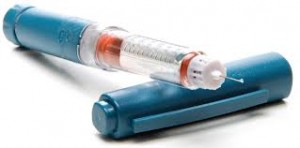What is diabetes?
Diabetes is caused by deficiency of insulin, which is an important hormone made by beta cells in the pancreas. The signs of diabetes in dogs are typically weight loss despite a good appetite, and excessive thirst and urination.
How is diabetes treated in dogs?
Treatment of diabetes in dogs usually requires daily administration of insulin injections and appropriate nutrition, and must be specifically tailored for each individual. The goal is to control the signs of diabetes (weight loss despite a good appetite; excessive thirst and urination) and to avoid low blood sugar (hypoglycaemia) due to insulin over-dose. The best outcome tends to be achieved when the owner of the diabetic pet and their veterinarian work together as a team.
What is diabetic remission?
Diabetic remission is a period of time when a diabetic animal does not require insulin injections to control the signs of diabetes.
What commitment is required at home when treating a diabetic dog?
- Insulin injections are typically administered by the owner to a diabetic pet every 12 hours. It is very important that injections are given at the exact time that they are due. If it is ever not possible to give an insulin injection on time, then it is better to miss that particular injection than to give it at another time.
- Appropriate nutritional strategies can complement insulin therapy in diabetic dogs and so it is often beneficial to make changes to the diet or feeding regimen.
- Information collected at home about a diabetic dog’s progress helps to monitor the success of treatment and can provide clues about the risk of hypoglycaemia. The most useful information comes from routine recording of general demeanour, daily water intake, changes in body weight, and the presence or absence of glucose in the urine.
Collecting important information about your diabetic dog
- Appetite, general demeanour and behaviour. This should be recorded every day.
- Insulin dose and meal composition. This should be recorded twice each day.
- Water intake. This should be measured at least once each week. The key is to determine how many millilitres of water your dog drinks over a known number of hours. For example, a measured volume of water can be provided in a bowl and access to other water sources should be prevented. The volume of water remaining in the bowl can then be measured after 24 hours. If there is more than one pet drinking from the same water bowl, it is useful to measure the volume of water drunk by all the animals. The diabetic dog typically is the reason for most of the variation in water drunk in multi-pet households.
- Urine glucose and ketones should be measured at least once each week. The urine can be tested with test strips called Ketodiastix and a record kept of the results. Diabetic dogs will often need a bit of gentle encouragement to become accustomed to their owner approaching them when they are urinating. However, most will come to readily accept urine collection.
- Body weight. Ideally, a diabetic dog’s body weight should be recorded once each week. It is important to use the same scales each time the dog is weighed. Scales designed for weighing adult humans are not suitable for small dogs. Scales designed for babies are a suitable option.
Link to an Excel spreadsheet that can be used for recording information about your diabetic dog. The first row has been filled in as an example.
Advantages of using an insulin dosing pen
 Insulin dosing pens are designed for use by people with no medical training. They are easy to use, more accurate and precise for dose measurement, and are less painful for the patient. Insulin dosing pens for diabetic dogs are re-useable and so the only ongoing costs are for the pen tips (needles) and the insulin cartridges. In many cases, these ongoing costs are less than for standard insulin, syringes, and needles. Insulin dosing pens can administer doses in 0.5 Unit increments and so a diabetic dog might, for example, be accurately given 5.5, 6.0, or 6.5 Units of insulin according to its needs. Insulin dosing pens are designed to work with specific insulin preparations and so it is sometimes necessary for a diabetic dog to be changed to a different insulin preparation when changing from syringes and needles to a dosing pen. The technique for administering insulin using a dosing pen is quite different to that for syringes and needles and so an introductory training session is required before using a pen at home.
Insulin dosing pens are designed for use by people with no medical training. They are easy to use, more accurate and precise for dose measurement, and are less painful for the patient. Insulin dosing pens for diabetic dogs are re-useable and so the only ongoing costs are for the pen tips (needles) and the insulin cartridges. In many cases, these ongoing costs are less than for standard insulin, syringes, and needles. Insulin dosing pens can administer doses in 0.5 Unit increments and so a diabetic dog might, for example, be accurately given 5.5, 6.0, or 6.5 Units of insulin according to its needs. Insulin dosing pens are designed to work with specific insulin preparations and so it is sometimes necessary for a diabetic dog to be changed to a different insulin preparation when changing from syringes and needles to a dosing pen. The technique for administering insulin using a dosing pen is quite different to that for syringes and needles and so an introductory training session is required before using a pen at home.
For this and further general information for diabetic dogs, download this PDF.
